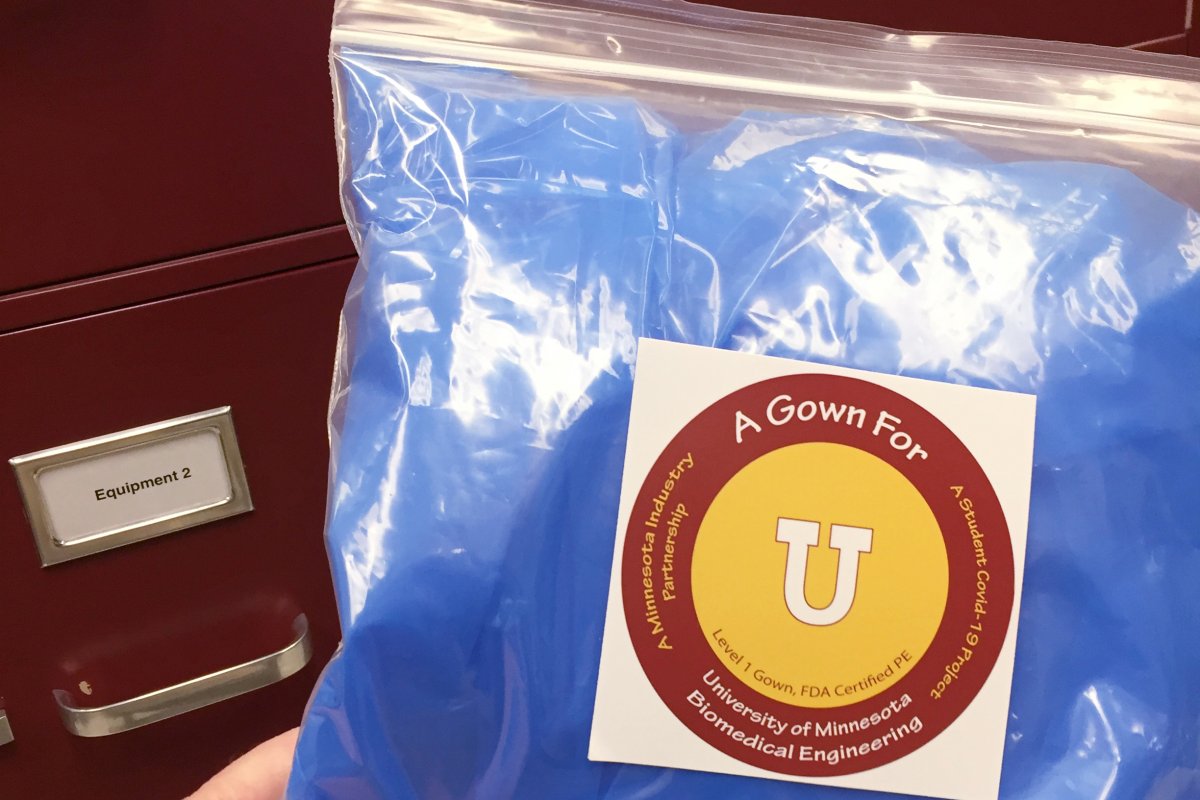A swift response

Above: Early in the pandemic, the University of Minnesota's Institute of Engineering in Medicine assembled teams to address COVID-related needs in the medical community. The results included 3 types of protective masks (MNmask style 1 pictured) and a respiratory procedure box to protect healthcare providers when treating COVID-19 patients.
IEM enables researchers to collaborate more efficiently
December 23, 2020
When the coronavirus hit in March 2020, shortages in medical equipment grew. Hospitals lacked sufficient ventilators to treat patients, and medical personnel lacked the PPE they needed to provide care safely. Faculty and industry leaders at the University of Minnesota’s Institute of Engineering in Medicine (IEM) started brainstorming.
“Professor David Odde (biomedical engineering) reached out to our industry advisory board because there was an urgent lack of PPE in the supply chain,” explained IEM director John Bischof. “Everybody hopped on a call and started talking about ways they could help.”
Formed in the 1990s along with the University’s Department of Biomedical Engineering, the institute has since evolved, bringing together U of M researchers in CSE and the Medical School to foster collaboration and improve healthcare. Bischof, both the Carl and Janet Kuhrmeyer Chair in Mechanical Engineering and the Medtronic-Bakken Endowed Chair for Engineering in Medicine, reports to the deans of both schools in his leadership role. As an engineer with projects in the Masonic Cancer Center, his work bridges both engineering and medicine.
Bischof, along with IEM clinician engagement faculty directors Will Durfee (mechanical engineering) and Brad Benson (medical school), began assembling teams to address COVID-related needs in the medical community. They worked closely with the vice presidents of supply chain management at M Health Fairview to determine where and what PPE was needed most.

Within weeks, University researchers designed three different types of face masks, dubbed the MNmask, from repurposed filtration material. At the same time, a team in IEM’s Earl E. Bakken Medical Devices Center constructed a low-cost ventilator alternative for physicians to use.
By May 2020, an IEM team led by mechanical engineering professor Chris Hogan had developed a respiratory procedure box to protect healthcare providers treating COVID-19 patients and a phone booth-like structure to improve virus testing processes. Biomedical engineering students also produced disposable protective gowns for health workers, of which 350,000 have now been made. And the list goes on—most of the designs are also available online (z.umn.edu/IEMcovid) for researchers and health professionals around the world to use.
According to Bischof, this swift, organized response to the coronavirus pandemic wouldn’t have been possible without IEM.
“There’s no other umbrella organization for biomedical engineering like this on campus that can do this,” he said.
“It’s been a way to connect people and give a coherent response to COVID, because we can help engineers meet clinicians, we can help fund some of these initiatives, and we can connect to industry. We have enough resources that we can have multiple programs to serve faculty and do things that are bigger than individual research programs.”
Since March, IEM, in collaboration with the Minnesota Robotics Institute and the Clinical Translational Science Institute, has given out about $300,000 in grants for U of M faculty to work on COVID-related issues. Thanks to its umbrella structure, grant-writing services, and wide-ranging connections on both the medical and engineering fronts, the institute allows researchers to collaborate more efficiently and effectively on projects and writing grants.
“We faculty are hired into departments to focus on specific research, teaching, and service. While this focus creates individual excellence in faculty, it does not always facilitate larger initiatives,” Bischof said. “We’re in a moment right now with COVID where we can focus on and support larger initiatives, build teams, and work together to build community in academics. I think IEM is the ideal vehicle for that.”
By Olivia Hultgren
Read more stories from our Winter 2021 college magazine.
If you’d like to support research at the University of Minnesota College of Science and Engineering, visit our CSE Giving website.
